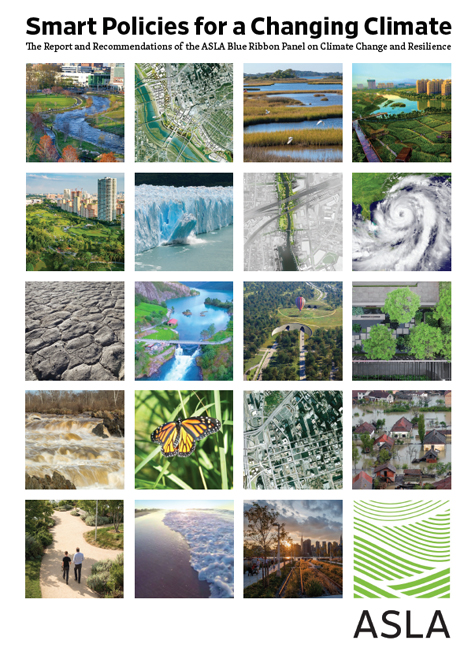Professional Practice
Climate Change Mitigation: Green Infrastructure
Download Report:
According to the U.S. Green Building Council, buildings consume 70 percent of the total U.S. electricity load. Landscape architects plan and site buildings for energy efficiency, using green infrastructure and natural systems to maximize emissions reductions, while helping communities adapt to a changing climate and improve resilience.
Green roofs and green walls keep buildings cooler in the summer and warmer in the winter, reducing energy needed for heating and cooling. In one study, a green roof in Ottawa, Canada was found to reduce energy demand for cooling by more than 75 percent. Green roofs can also be as much as 90° F cooler than a conventional rooftop, reducing the urban heat island effect. While specific energy savings will depend on location, climate, and design specifics, the bottom line is that green roofs contribute to meaningful reductions in building energy demand.
Outdoor landscape design can also help buildings reduce their energy demand. Planting deciduous trees on the southern and western sides of a building can offer shade from intense summer sunlight, reducing energy needed for cooling. A 2009 government study found that just one tree could reduce a house’s emissions from summer electricity use by an average of 31 percent over a 100 year period. Trees can be used for windbreaks, too. A North Dakota study found that windbreaks could help houses cut winter fuel consumption by 40 percent.
Using water also requires energy. Twenty percent of California’s total electricity use is spent just getting water to residents, businesses, and farms. According to Project Drawdown, reducing household water consumption could avoid 4.6 billion tons of GHG emissions by 2050. Because more than 30 percent of total household water use occurs outdoors, the design of a home or building’s surrounding landscape can have a meaningful impact on total emissions.
Landscape architects create water efficient landscapes that require minimal irrigation and save energy. They work with a site’s terrain and structures to capture, direct, and reuse rainwater. And by planting regionally-appropriate native plant species that have evolved to thrive within the given environment, landscape architects create beautiful, ecologically-functional outdoor landscapes that require less irrigation and other forms of maintenance.
All of these efforts make communities and residences more adaptable and resilient to climate shocks.
Resources
ASLA Green Roof
D.C. Is Turning Green On Top, Landscape Architecture Magazine
The International Greenroof and Greenwall Projects Database
Using Green Roofs to Reduce Heat Islands, U.S. Environmental Protection Agency
Energy
Energy Efficient Home Landscapes, American Society of Landscape Architecture (Animation)
Landscaping Tips for Energy Efficient Homes, U.S. Department of Energy
Sustainable Residential Design: Increasing Energy Efficiency, American Society of Landscape Architects
Water
Leveraging the Landscape to Manage Water, American Society of Landscape Architects
Soak Up the Rain: Green Roofs, U.S. Environmental Protection Agency
Sustainable Residential Design: Improving Water Management, American Society of Landscape Architects
U.S. Cities Can Save Billions with Green, Resilient Design, says Report, Curbed, February 8, 2018
Interview with Christine Ten Eyck on the Beauty of Drought, The Dirt blog, December 18, 2015
Research
The Outdoor Microclimate Benefits and Energy Saving Result from Green Roof Retrofits, Umberto Berardi, Energy and Buildings, June 2016
Temperature and Cooling Demand Reduction by Green-roof Types in Different Climates and Urban Densities: A Co-simulation Parametric Study, Tobi Eniolu Morakinyo et al, Energy and Buildings, June 2017
Green Roof Research, Michigan State University
Low Carbon Districts: Mitigating the Urban Heat Island with Green Roof Infrastructure, Steffen Lehmann, City, Culture and Society, March 2014
Seeding Green Roofs for Greater Biodiversity and Lower Costs, Richard Sutton, FASLA
Projects
A New Norris House and Landscape, Norris, TN
University of Tennessee College of Architecture and Design
Burbank Water and Power Eco Campus, Burbank, CA
AHBE Landscape Architects
Connecticut Water Treatment Facility, New Haven, CT
Michael van Valkenburgh and Associates
Brooklyn Botanic Garden Visitors Center, Brooklyn, NY
HMWhite
California Academy of Sciences, San Francisco, CA
SWA Group
Museo del Acero Horno3, Monterrey, Mexico
Surfacedesign Inc. + Harari arq
Nueva School, Hillsborough, CA
Andrea Cochran Landscape Architecture
Underwood Family Sonoran Landscape Laboratory, Tucson, AZ
Ten Eyck Landscape Architects, Inc.